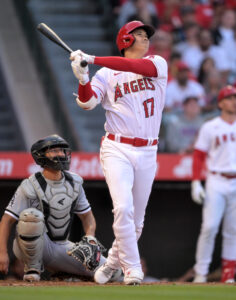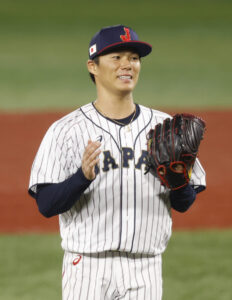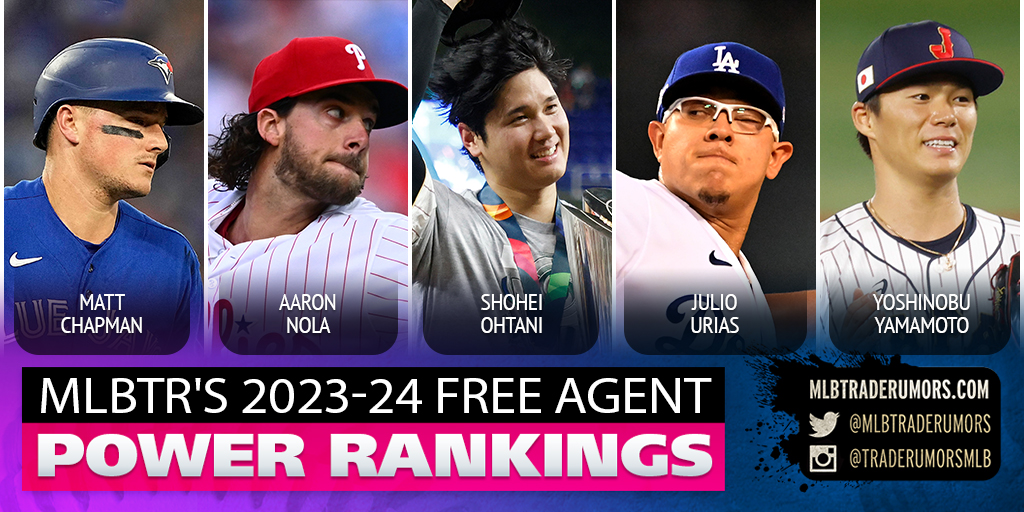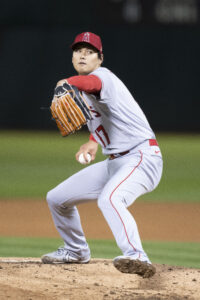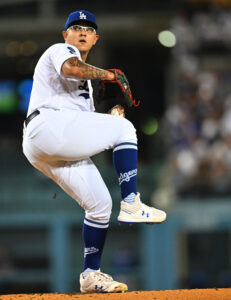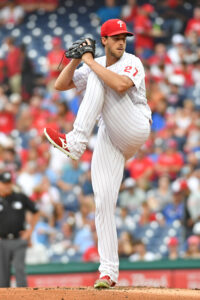We’re a few days from the beginning of the offseason, with the World Series concluding no later than Saturday. One of the first orders of business is the qualifying offer, which will have to be issued within five days of the beginning of the offseason.
A player is eligible for a qualifying offer if they have never received one before and spent the entire season with the same club. The value of the QO changes annually, calculated by taking the average salary of the 125 highest-paid players in the league. That means it generally rises as salaries increase over time, with this year’s QO expected to land around $20.5MM. If a player receives and rejects a qualifying offer, he becomes a free agent. If he then signs elsewhere, the signing team is subject to draft pick forfeiture and possibly other penalties, while their previous club receives draft pick compensation.
Yesterday, MLBTR’s Darragh McDonald looked at which pitchers were potential QO recipients. Today, we’ll take a look at the offensive class.
No-Doubters
- Cody Bellinger (Cubs)
- Matt Chapman (Blue Jays)
- Shohei Ohtani (Angels)
This trio is well on its way to nine-figure deals. Ohtani should set the all-time guarantee record, while Bellinger could surpass $200MM. Chapman had a rough second half offensively, which drops him well behind the top two hitters in the class. There’s virtually no chance he’d accept the QO, though, as his plus glove and slightly above-average offense gives him a shot at five or six years.
Likely Recipient
- Teoscar Hernández (Mariners)
Hernández had a middling season in Seattle, hitting .258/.305/.435 through 676 trips to the plate. While he connected on 26 home runs, he did so with his lowest batting average and on-base percentage since his 2020 breakout with the Blue Jays. Hernández helped carry the Mariner lineup in June and August but was a well below-average player in every other month.
The down year may knock the 31-year-old from an absolute lock to reject the QO to “merely” very likely to do so. He hit .283/.333/.519 in over 1300 plate appearances between 2020-22. Teams can point to this year’s home/road splits as a potential factor in Hernández’s offensive downturn. He hit only .217/.263/.380 at Seattle’s pitcher-friendly T-Mobile Park while running a typical .295/.344/.486 line on the road. Perhaps that’s an indicator he’s not a great fit for the Mariners specifically, but it also boosts his chances of declining a QO to land a multi-year deal elsewhere.
Corner outfielders like Avisaíl García and Kyle Schwarber have found four-year guarantees with less consistent career track records than Hernández has compiled. While neither of those players were attached to draft compensation, Hernández could find a four-year pact even with the QO — particularly in a free agent class so light on impact bats.
Possible Candidates
- Mitch Garver (Rangers)
Entertaining a qualifying offer for Garver would have seemed absurd a few months ago. He’d been limited to 54 games in 2022, working mostly as a designated hitter, by a flexor injury that eventually required season-ending surgery. Garver lost another six weeks to a left knee sprain early this year. By the time he returned, Jonah Heim had cemented himself as an All-Star catcher.
That left Garver as a high-quality backup and potential DH. Since returning from the knee injury, he has mashed his way to the middle of a fearsome Texas lineup. Garver hit 17 homers in 81 regular season games after his activation, posting a .271/.369/.495 line. He stepped in behind the plate while Heim was out with a wrist injury, then moved seamlessly back to DH upon the latter’s return. Garver has connected on three more homers in 51 postseason plate appearances, running a .244/.333/.489 mark in October.
This kind of offense isn’t out of nowhere. Garver hit 31 homers in 93 games for the Twins in 2019. He’s a career .252/.342/.483 hitter. When healthy, he’s a very good offensive player. He’s certainly one of the best hitting catchers in the league. The health caveat has been important, though, as he has only once topped 100 games in a season. Garver has spent time on the injured list every year since 2019 and has caught just 354 innings over the last two seasons. He’ll turn 33 in January.
Is Garver capable of holding up as a team’s #1 catcher? That’s debatable. He wouldn’t need to do that for Texas, as he could remain in the DH/#2 catcher role alongside Heim if the Rangers retain him. There’s a good chance he’d accept a QO if offered — he has never made more than $3.9MM in a season — but the Rangers run lofty payrolls and don’t have many other key free agents. Texas showed a (regrettable in hindsight) willingness to gamble on a qualifying offer for Martín Pérez after a strong platform year in 2022. They could do the same with Garver.
- Rhys Hoskins (Phillies)
Hoskins lost the entire 2023 season after tearing the ACL in his left knee during Spring Training. He had progressed to taking batting practice and running the bases in recent weeks, leaving open the possibility for a return as a DH had the Phillies made the World Series.
With Philadelphia coming up a game short, the ’23 campaign goes down as a complete lost year. Heading into the spring, Hoskins projected as one of the best hitters in the upcoming free agent class. He’s a consistent 25-30 homer bat who takes plenty of walks. Hoskins is a career .242/.353/.492 hitter. Even in the absence of defensive or baserunning value, he tends to accrue two to three wins above replacement annually.
Since his profile isn’t built on athleticism, Hoskins may well go into 2024 the same player he was expected to be six months ago. He may still be looking for a one-year deal that allows him to retest the market after a stronger platform season, when he’d be entering his age-31 campaign.
A qualifying offer could be mutually beneficial. Hoskins would be able to play out his rebound year with the only organization he has ever known, while Philadelphia would retain a middle-of-the-order presence without long-term downside. The biggest wild card may be Bryce Harper’s positional future. He played DH and first base after undergoing Tommy John surgery last November. If the Phils are comfortable with his arm back in right field, retaining Hoskins at first and pushing Kyle Schwarber to DH is reasonable.
- J.D. Martinez (Dodgers)
While Martinez feels like a player who should have received a qualifying offer at some point in his career, he has not. A midseason trade rendered him ineligible before his free agent trip in 2018. The Red Sox opted against the QO when he hit free agency last offseason. He signed a one-year, $10MM pact to reunite with hitting coach Robert Van Scoyoc in Los Angeles.
Martinez turned in his best offensive season since 2019. He popped 33 homers in 479 plate appearances, posting a .271/.321/.572 slash. A career-high 31.1% strikeout rate is a little alarming, but it’s not all that important so long as Martinez is hitting for the kind of power he did this past season. He made hard contact (a batted ball at 95+ MPH) on 55.1% of his balls in play. That’s his highest mark of the Statcast era and a 98th percentile figure in MLB.
The Dodgers could certainly entertain the qualifying offer. They have less than $100MM in salary commitments for 2024. Given their prior spending habits, they have as much short-term payroll space as any team. If Martinez replicated his ’23 production, he’d easily be worth a $20.5MM investment for one season.
In most years, this would be a fairly easy call for L.A. Complicating matters this particular winter: Ohtani’s presence. The Dodgers are expected to be a key suitor for the likely AL MVP. Martinez made all of one start in left field during his age-35 season. Ohtani’s free agency will carry beyond the deadline for the Dodgers to decide whether to issue Martinez a QO (and past his allotted five-day window to decide whether to accept if offered). A player who accepts a QO receives automatic no-trade rights until June 15 of the following season.
If Martinez accepts, the Dodgers are either committed to playing him in left field on most days or (less likely) out of the Ohtani mix. They may not want to risk limiting their flexibility within the first week of the offseason.
- Jorge Soler (Marlins)
Soler is very likely to decline a $13MM player option. The right-handed slugger will head back to free agency after a strong season in Miami. Soler hit .250/.341/.512 while blasting 36 home runs across 580 trips to the plate. He walked at a strong 11.4% clip while striking out at a manageable 24.3% rate.
The 2023 version of Soler is a middle-of-the-order power presence. He has demonstrated that ability in spurts throughout his career, including a 48-homer showing in Kansas City five seasons back and a monster second half to help the Braves to a championship in 2021. He’s not a consistent impact bat, though. Between 2020-22, he ran a middling .219/.312/.425 line in over 1000 plate appearances. For a well below-average corner outfielder who is best suited as a designated hitter, league average offense won’t cut it. Soler was only marginally above replacement level over that three-year stretch overall.
A player’s platform year performance is the biggest factor in whether he receives a qualifying offer. Soler’s 2023 campaign would be good enough to warrant it on many teams. Are the Marlins one of them? Miami would be hard-pressed to find consistent power production if they let him walk. At the same time, they’re an organization that typically runs payrolls below $100MM. Soler accepting a QO would be a legitimate possibility. Miami may not want to risk tying up a fifth of its player budget to a DH with an up-and-down track record.
Long Shots
- Lourdes Gurriel Jr. (D-Backs)
Acquired alongside Gabriel Moreno in the Daulton Varsho trade, Gurriel had a solid season in Arizona. He hit a career-high 24 homers with a .261/.309/.463 slash in 592 plate appearances. He was a first-time All-Star, largely on the strength of an otherworldly performance in May. Gurriel went ice cold midseason but rebounded with a .291/.338/.497 showing from the start of August through the regular season’s conclusion. He hasn’t contributed much offensively in Arizona’s World Series run.
Heading into his age-30 season, the Cuba native has a case for a solid multi-year deal. He’s a good contact hitter with 20+ homer power but middling walk rates. After years of inconsistent defensive production, he has played strong left field defense in the desert. Gurriel is a good player, although a salary in excess of $20MM is probably beyond Arizona’s taste.
- Kevin Kiermaier (Blue Jays)
Shortly before the Gurriel trade, the Jays signed Kiermaier to a one-year, $9MM deal. Their career division rival turned in a strong season in Toronto, pairing league average offense with sublime defense. He hit .265/.322/.419 over 408 trips to the plate. In just under 1000 innings in center field, Kiermaier rated anywhere between 12 and 18 runs above average by measure of Statcast and Defensive Runs Saved.
That certainly earns him a raise relative to his last free agent trip, when Kiermaier was coming off a platform year cut short by hip surgery. Potentially more than doubling his salary by issuing the QO seems like a bridge too far, however. Kiermaier turns 34 in April and has a lengthy injury history. Committing over $20MM for one season would be a bet on him staying healthy all year.
Ineligible
- Josh Bell (Marlins)
- Brandon Belt (Blue Jays)
- Jeimer Candelario (Cubs)
- Michael Conforto (Giants)
- Justin Turner (Red Sox)
Bell and Candelario changed teams midseason, rendering them ineligible for the QO. Belt, Conforto and Turner have all previously received the offer. Of this group, only Candelario and perhaps Turner would likely have gotten a QO even if they were eligible.

